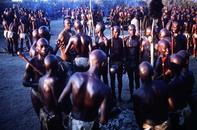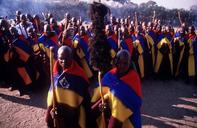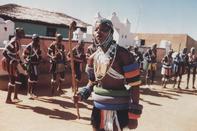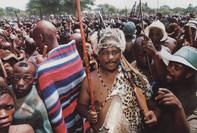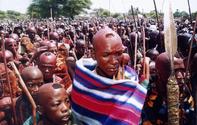
Further Variations in Male Initiation Practices
Ceremonies of South Africa
The initiation ceremonies (ingomaorukuwela) attended by Ndebele men take place every four years. These two-month rites of passage are always held during the winter.
At the end of the initiation period, Ndebele initiates receive regimental names with which they identify themselves for life. The Ndzunda-Ndebele use fifteen such names over a period of approximately sixty years, while the Manala-Ndebele use thirteen.
Although Ndebele rites are controlled and administered by the royal house, they are decentralized over a wide area, taking place in both rural and urban centres. Regional headmen are assigned to supervise the ritual process.
Chief Sam Mankuroane was instrumental in reviving initiation rites among the Batlhaping, a sub-section of the Tswana nation. A member of the Congress of Traditional Leaders of South Africa (CONTRALESA), over 2,600 youths and almost 800 young women attended his initiation schools in the late 1990s.
While Batlhaping youths now wear colourful blankets and beads at their coming-out ceremonies, in the past these and other initiates received leather karosses from their families. Like initiates from other parts of the country, they shave their heads when they first enter the initiation school as a symbol of their transitional status, and carry sticks as a symbol of their new status as adults on their return to the community.
By
Professor Sandra Klopper